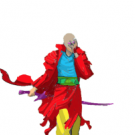-
Posts
1141 -
Joined
-
Last visited
-
Days Won
2
Ripheus23's Achievements
988
Reputation
Single Status Update
-
The Daykey and the Fifth Nothingness
At one point in the first Critique, Immanuel Kant comes up with another one of his random tables of categories and it has to do with the concept of nothingness. He basically says that this concept is what is common to the four categories he tabulates. Now one character in this story is supposed to be walking by a wall in a weird city one time, and he's supposed to see a message written on it (graffiti, blood, IDK): "Apollyon came to destroy that which does not exist." This is supposed to be super-foreshadowing of the endgame, since I want the "let's destroy the Form of Evil by turning it into the Form of Nothingness" to be the endgame danger, but not to be clearly stated ever beforehand. (Like, the idea that there even is this particular danger is not stated outright before, or that Apollyon could even have Its own ultimate plan.)
So, the meta-form of nothingness that encompasses the four categories, might be thought of the Fifth Nothingness. But actually this is a phrase or title that is supposed to show up at random, another shadow-clue, to point towards the end, because the Form of Destruction might be thought of as the fifth Form of Nothingness in the sense that destruction is that which causes nonexistence. And Apollyon is wielding the essence of the Form of Nothingness itself also, in the endgame. So, the shadow-phrase points towards this event.
It also points towards its explanation in terms of the magic system in the story. So, one way to put the theme of the story is "programming the multiverse using the transfinite numbers." Or, "solving word problems in algebra by using the transfinite numbers." Whichever of those descriptions resonates with you, if either. To "program" the Keyscape, which is what allows physical beings to directly use magic, they had to use the transfinite numbers.
This is defined, first, from the notion of keying one aleph-number to another. The idea is that every aleph-number has a cardinality and an ordinality, and a transcardinality (which, under the definition, can also be called a transordinality). Two sets that differ in cardinal or ordinal rank, can have the same transcardinal rank. Sets of elements with the same transcardinal rank are known as transets. So, there's an economic transet, which is the transcardinal rank of the 24 universes (the "phenomenal economies") together. What the Host of Ripheus did long ago, was to use the seleplex artifexium to key aleph.1 through aleph.24 to arbitrarily "higher" (cardinally or ordinally greater) aleph-numbers, and these 24 arbitrarily indexed sets are all in the same transet. This is known as the isoarchic transet since the elements are all equal in rank and this equality is decided instead of inherent. An instrument known as the Daykey is what the Host of Ripheus used to make that decision (an adjunct to the seleplex artifexium, along with a crystal isoplex array). In turn, the elements of the economic transet are keyed to the elements of the isoarchic transet, establishing the necessary "link."
If you're with me so far: Apollyon has Its own transet. This is the transet of the Form of Nothingness. Now, there are also four forms of the finite-nonfinite difference (finite, indefinite, infinite, absolute), and the Final Power comes from keying the elements of the isoarchy to the angles of the Square of Metafinity (another transet). However, when Vyrian Armirex gives His share in the Final Power to Apollyon, the Destroyer can key Its transet itself, to the entire Square itself as a transet.
One of Apollyon's powers is known as Contradiction. (Unprovable objects, objects defined as absences, empty objects: fictitious, privative, and ur-plenary functions are the other three Forms of Nothingness listed (not in those terms) by Kant.) This is the harshest of the Nothingness-Forms so it becomes the image of the transcreation of all possible evil, simultaneously iterated with the destruction of all that evil, to infinity.
So there's actually a totally different original, and still necessary, reason for Apollyon to have a fourfold tower at Its center...




